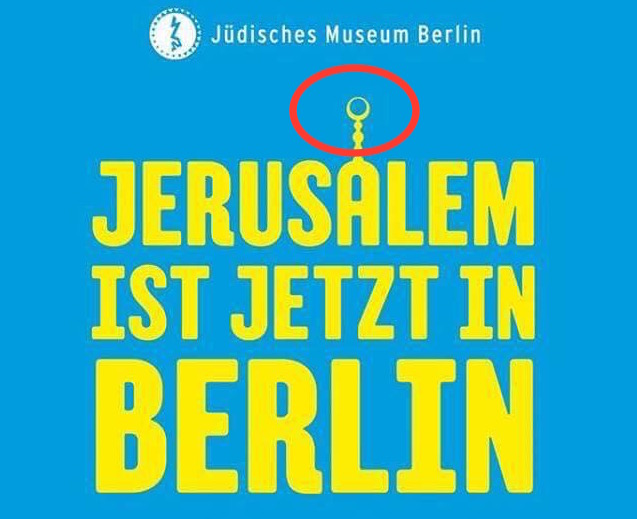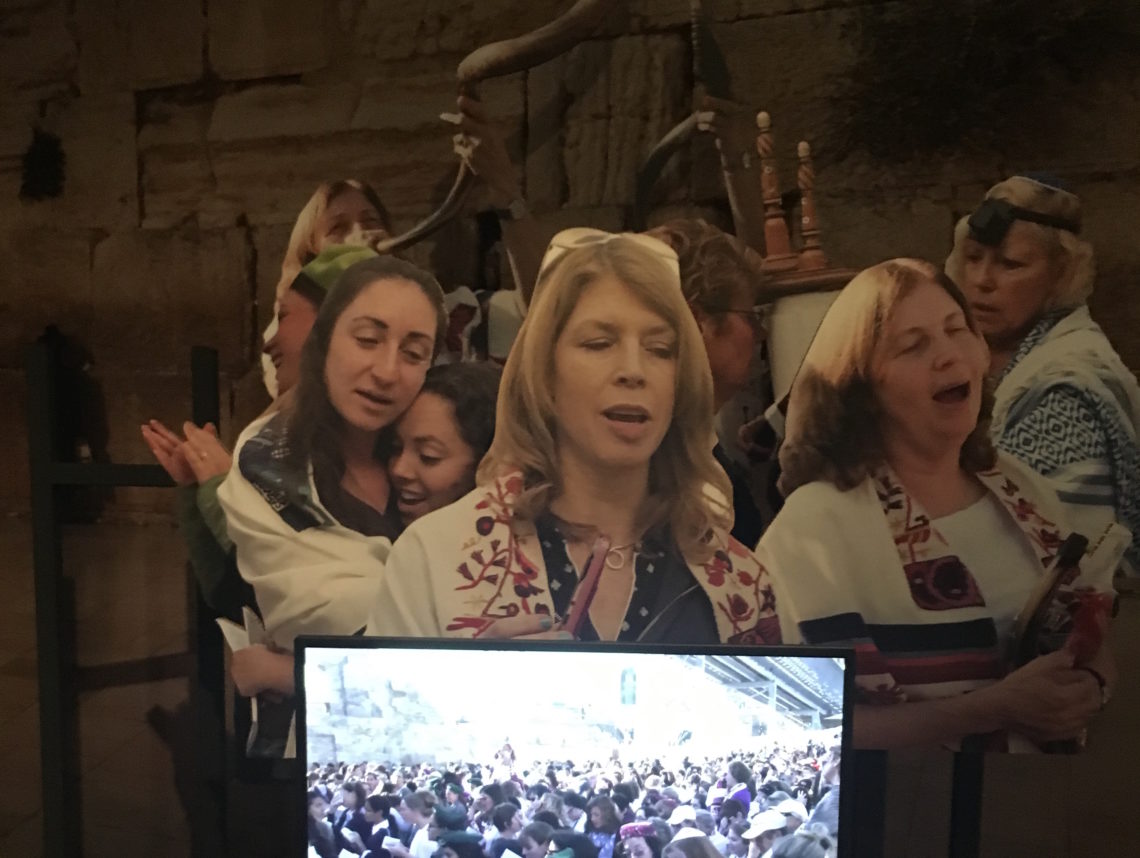
As Jewish Museum Berlin’s Director, Peter Schaefer, stated in our interview for the Jewish Journal of Los Angeles, the Museum seeks for its temporary exhibitions, whenever possible, to explore topics of importance to all three major religions (which makes one wonder why it’s called the “Jewish Museum”). No topic captures the interreligious imagination more than Jerusalem, but the “Welcome to Jerusalem” exhibition seems to serve as a platform for the Museum to subtly impose its political bias regarding Israel, despite proclamations to the contrary.
As someone who has lived, loved, and cried in this troubled and glorious city through some of its bloodiest and most exciting times, I present to you the exhibition’s top ten fail moments:

10. Islam is the rightful heir to Jerusalem. The Islamic crescent topping the Dome of the Rock is the only religious ornament on the Museum’s brochure and initial city ads. Forget the Jewish star. Forget the cross. In the “The Holy City” section, Conrad Schick’s impressive model of Dome of the Rock takes center stage, flanked by a modest model of the Western Wall and the Church of the Holy Sepulcher, thereby giving “Haram esh-Sharif” (or Noble Sanctuary) dominance.
 9. Theodor Herzl and Yasser Arafat are moral equals. In a strange section on dignitaries buried in Jerusalem, Herzl and Arafat are listed side-by-side, as if this intellectual, non-violent Zionist leader and this antisemitic arch-terrorist are moral equals. As if the Zionist cause that turned swampland into civilization is equal to the Palestinian cause that turned nails and screws into shrapnel. No mention is made of Arafat’s role in mercilessly murdering Jews via suicide bombings at bus stops, cafes, and nightclubs. While Arafat’s mausoleum is in Ramallah, the placard suggests he should be buried in East Jerusalem, as the future capital of “Palestine.”
9. Theodor Herzl and Yasser Arafat are moral equals. In a strange section on dignitaries buried in Jerusalem, Herzl and Arafat are listed side-by-side, as if this intellectual, non-violent Zionist leader and this antisemitic arch-terrorist are moral equals. As if the Zionist cause that turned swampland into civilization is equal to the Palestinian cause that turned nails and screws into shrapnel. No mention is made of Arafat’s role in mercilessly murdering Jews via suicide bombings at bus stops, cafes, and nightclubs. While Arafat’s mausoleum is in Ramallah, the placard suggests he should be buried in East Jerusalem, as the future capital of “Palestine.”
 8. Left-wing perspectives inform the exhibition. In the final hall, a panel consists of excerpts on Jerusalem current affairs from mainly Left-wing publications, allowing for little ideological diversity: Ha’aretz, The Guardian, New York Times, to name a few.
8. Left-wing perspectives inform the exhibition. In the final hall, a panel consists of excerpts on Jerusalem current affairs from mainly Left-wing publications, allowing for little ideological diversity: Ha’aretz, The Guardian, New York Times, to name a few.

7. Israel is a land hoarder. In an illustration of Jerusalem’s changing boundaries, Israel is blamed for robbing the Palestinians of land, saying: “Arab eastern Jerusalem has become increasingly separated from its hinterland” because of the security barrier. No context is given for it: a response to the relentless, cruel terrorist attacks against Israel coming from the West Bank/Judea and Samaria.

6. Even hotels are political. Another strange exhibit on famous Jerusalem hotels seems to have been devised to showcase the most famous Zionist “terrorist” attack when, in 1946, the Irgun military underground blasted the wing of the King David Hotel housing the British administrative headquarters. (It also affords the Museum an opportunity to portray dignitaries who visited Jerusalem, with an unflattering picture of Trump.)


5. Only Jewish “extremists” exist. Another odd room is dedicated to Jewish fringe groups: the liberal “Women of the Wall”; the anti-Zionist “Neturei Karta”; and “Temple Mount Faithfuls” who seek to rebuild the Third Temple, which, according the Museum, “exacerbate[s] the conflict between Israel and Palestine.” Where’s the room dedicated to the far more numerous Muslim extremists who do more than just practice outdated rituals? Why not dedicate a room to Koran passages that incited the attempted murder of Yehuda Glick (now a Knesset member) who advocated for freedom of worship on the Temple Mount, where the Islamic Waqf forbids Jewish prayer? And what about the terrorist gang that gunned down young Arab Druze policemen who protected Jews during “non-Muslim” visiting hours?

4. Mocking Israeli leaders. Next to the Jewish “extremists,” the Museum placed a cutout of Israeli Minister of Culture Miri Regev sporting the dress she wore at the Cannes Film Festival whose hem was decorated with the Jerusalem landscape. Next to her are samples of social media posts mocking her. Why pick on an Israeli leader? Why not mock Arab lawmakers who spew the kind of antisemitism that would make Hitler proud?

3. Israel was a “Catastrophe” (Naqba). The climax of the exhibition is a short film, “Conflict,” that paints the conflict with anti-Israel canards. The wondrous 1967 Israeli victory is described to ominous, eerie music; the Museum was clearly not happy Jews won the self-defensive war that enabled them to liberate Biblical lands from Jordan’s illegal occupation. The film describes how hundreds of thousands Palestinians were displaced during the War of Independence and singles out the Israeli army’s Der Yassin “massacre,” which, according the film, became the symbol of the “Naqba” (as Arabs termed Israel’s victory). We are hardly told of the countless massacres against Jewish innocents that Arabs perpetrated since before Israel’s founding. Arafat reappears as a “freedom fighter” against the “Occupation.”
2. Jews are insects. The exhibition hardly includes any original constructions, except for a model of Herod’s Temple, but it doesn’t seem to have been made as homage to Jewish claims to the precinct. Around the Temple, goggles take the viewer through 3D images of esoteric Temple practices, like burnt offerings, as if to portray Jews as primitives who slaughtered sheep for their weird cults. But the strangest choice is the decision to map movements of Jews through black dots. (Who really cares about Jewish foot traffic?) They don’t look like people. They’re ants, recalling the antisemitic comparison of Jews to insects. Anyone up for a job of extermination?

1. Jerusalem is only politics. There is so much more to Jerusalem than just conflict. There’s Arab-Jewish coexistence, culture, cafes, delicious restaurants, colorful souks, new boutique hotels and hostels, student hangouts, university life, beautiful landscapes. Hardly any deep love, intimacy, empathy, or passion for the city comes through. So my suggestion is to go instead to the real thing. This year in Jerusalem.
Orit Arfa is a journalist and author based in Berlin. Her second novel, Underskin, is a love story of Berlin and Tel Aviv.























 More news and opinions than at a Shabbat dinner, right in your inbox.
More news and opinions than at a Shabbat dinner, right in your inbox.